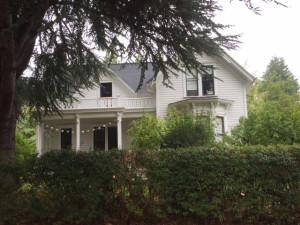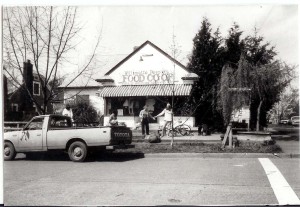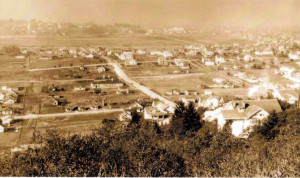Welcome to Historic the South University Neighborhood
The South University neighborhood connects important pieces of Eugene’s history, from the Masonic Cemetery at the South, to the I.O.O.F. Cemetery to the north, and to the University of Oregon, which boasts one of the state’s largest collections of historic buildings.
The Kalapuya Native Americas may have been early inhabitants of this area, as a dozen bands made their home in the Willamette Valley before the Euro-American exploration of the 1800’s spelled their demise, either through disease, conflicts with settlers, or forced relocation.

James Scott McMurray House 1885, Gothic Revival Click here for more info and walking Tour of the SUN
 Feilding McMurry, a Kentucky native who crossed the plains to Oregon in 1851, filed a 191-acre donation land claim for this area in 1866 and later purchased an additional 320 acres to the east. Portions of his farm property were sold to become the South University neighborhood, the two cemeteries and the University of Oregon campus. His son’s Gothis Revival house, built circa 1885, remains in the neighborhood (930 E. 21st Ave.).
Feilding McMurry, a Kentucky native who crossed the plains to Oregon in 1851, filed a 191-acre donation land claim for this area in 1866 and later purchased an additional 320 acres to the east. Portions of his farm property were sold to become the South University neighborhood, the two cemeteries and the University of Oregon campus. His son’s Gothis Revival house, built circa 1885, remains in the neighborhood (930 E. 21st Ave.).
The announcement of plans in 1906 for an electric streetcar line near the University signaled the development of the neighborhood, which was mostly still fields and orchards. the streetcar system (its tracks can still be seen on University Street (see walking tour), spurred local businessmen to purchase a large tract of land which was subdivided in 1907 as Gross’s Addition. The 420 lots ran from 18th to 23rd and from Alder to Agate; prices ranged from $50 to $500, with lots on University and Potter commanding the higher prices.
While the streetcar operated for only 20 years, the neighborhood thrived. Growth was slow from 1907 to 1920, then boomed as good economic times, population growth in Eugene and campus expansion all increased the demand for housing.
Close to 40 percent of the houses in the neighborhood were built during the 1920s, and by 1950, almost every lot in the area had been developed. Today the neighborhood contains an eclectic mix of early to mid-20th century houses. Houses range widely in size and degree of architectural detail, with the so called “high style” houses concentrated in the center of the neighborhood with required setbacks and houses becoming more modest on the streets near the eastern and western edges.
The neighborhood contains a variety of archectectuarl styles. A few pre-1907 houses still stand, including Italianate and Gothic Vernacular homes. The first houses built in Gross’s Addition were typically Bungalow and Craftsman styles.
As development continued in the 20’s, a large number of period revival houses were built. These revival styles included: Tudor, Mission, Colonial (including a Dutch Colonial variant), EnglishCottage, Norman Farmhouse, Mediterranean and Pueblo. This period also saw the construction of Edison School (1926), and nearby University High School (1921), McArthur Court (1926) and Hayward Field (1929).
Growth slowed during the depression years and picked up in the post-war years. Houses built during that period include World War II Era Cottages, Ranch houses, and Minimal Traditional style houses. The city acquired parcels for University Park in 1944 and 1945. The Eugene Active 20-30 Club installed a basketball court in 1949 and by 1950 the park boasted a variety of recreation facilities including the wading pool (now closed by the city).
The neighborhood, known for its rock walls, towering firs, mature landscaping and wide streets, retains its residential character with a healthy mix of families, students, retirees, professionals, and non-professionals. The current bounds of the neighborhood are the south side of 18th Ave from Patterson to Agate, the west side of Agate to 24th Ave, and the north side of 24th to Patterson St.
While SUNA has yet to be nationally recognized on the National Register of Historic Places as its current nomination is on indefinite hold, we can still appreciate it’s rich history, architectural styles, and the residents who have added to the colorful tapestry of the community.

The photo above depicts a scene from 1975 in front of a neighborhood co-op grocery store just across the street from Edison Elementary School.
Long time SUNA resident Sally Smith has this memory of this famously busy shop and street corner: “Son Doug was just talking about it when we walked by last week. He was at Edison from 1969-75-6. Steve remembers it too and he is 4 years ahead of Doug. Doug said they use to have half oranges with different flavors of candy cane stuck into them–you sucked on the candy like a straw! I use to buy cheese there. You cut it yourself off of a big block. The cheddar was great and much cheaper than at the grocery store. Great memories for all of our family.”
Learn more by clicking the links to pages below.

